Papers by Adèle Cassigneul
E-rea, 2019
This paper examines cross-dressing in Virginia Woolf’s Orlando. Reading the novel’s gender tops... more This paper examines cross-dressing in Virginia Woolf’s Orlando. Reading the novel’s gender topsy-turviness in light of the carnivalesque 1910 Dreadnought Hoax, for which Woolf cross-dressed as an Abyssinian Prince, I explore the seductiveness of queer non-conformity. Rather than focusing on Butlerian socio-political theories on gender, I underline the existential dimension of clothes trouble. Focusing on Orlando’s love relationships and following Clotilde Leguil’s Lacanian reading of gender vacillation, I contend that Woolf’s fanciful biography pertains to Cixous’s écriture feminine as it connects sexual difference, love and writing.
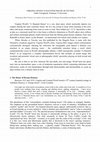
Journal of the Short Story in English, 2018
Virginia Woolf's "A Haunted House" thwarts all readerly expectations. The story at once endorses ... more Virginia Woolf's "A Haunted House" thwarts all readerly expectations. The story at once endorses and transgresses the rule of its genre, the ghost story, to become a playful and reflexive modernist text, a haunted intermediary space. In this article, I would like to suggest that the short story is haunted by texts and images and that this makes it a site of both inheritance and creative subversion, the very locus of early-twentieth-century literary crisis and experimentation.
//
« A Haunted House » de Virginia Woolf déjoue toutes attentes lectorielles. La nouvelle à la fois reprend et transgresse les lois de son genre, la ghost story ; elle s'impose comme un texte moderniste ludique et réflexif, véritable espace intermédiaire de hantise. Cet article analyse en quoi la nouvelle est hantée par des textes comme par des images ce qui en fait le site d'un héritage autant qu'un espace créatif de subversion, le lieu d'expression d'un geste expérimental émancipateur et d'une littérature qui, au début du vingtième siècle, est en crise.
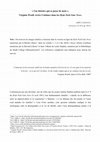
Littératures, 2018
Pour Virginia Woolf, le Hyde Park Gate News, journal familial manuscrit qu’elle compose avec son ... more Pour Virginia Woolf, le Hyde Park Gate News, journal familial manuscrit qu’elle compose avec son frère et sa sœur dans les années 1890, permet l’expression de l’intimité enfantine. L’exploration scripturaire qu’il met en scène s’impose comme un acte créatif et volontaire que je lis comme une performance autobiographique alliant texte et image. A l’interface entre le travail mimétique et le quotidien vécu, la jeune Virginia consigne son désir de sauver ce qui (lui) arrive, inscrivant par là, entre anecdote journalière et dessins spontanés, une dynamis propre à la représentation autobiographique qui s’allie ici à une pratique photographique régulière que les enfants relatent avec assiduité. Analysant les modalités intermédiales des journaux, je souhaite mettre au jour le lien ontologique dont ils témoignent entre la photographie et la vie de famille, entre l’acte photographique propre à la culture Kodak, la vie quotidienne domestique et la transformation du vécu en récit.
Études Britanniques Contemporaines, 2018
This paper will consider the notions of sight, vision and imagination in Ian McEwan’s Atonement... more This paper will consider the notions of sight, vision and imagination in Ian McEwan’s Atonement (2001) in order to try and offer a new definition of the author’s visual poetics. We will first focus on the frameworks moulding Briony’s vision, as a child and a fledgling writer. Watching events from the nursery, Briony’s gaze is explicitly defined as both childish and literary (melodramatic), reluctant and fascinated, a paradox which is materialized in the problematic blind spots of her obsessive vision. We will finally explain how the exploration of ‘vision’, as a theme and a poetics, connects McEwan to the literary tradition, as an heir to Conrad, but also creates an original and hybrid aesthetics of montage, which may ultimately have bearing on the ethical reading of Atonement.
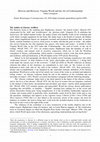
Etudes Britanniques Contemporaines, 2018
This paper will focus on Woolf as a literary practitioner and on two humble activities of hers,... more This paper will focus on Woolf as a literary practitioner and on two humble activities of hers, photo-cinematography and printing, which deeply influenced her approach to the ‘craft of words’ and helped her make of her humble publishing craft a hybrid revolutionary art. I will thus see in what ways Woolf was ceaselessly challenging the identity of literary creation as she exploited photography in Orlando, Flush and Three Guineas, mainly focusing on her use of amateur photography in Orlando and the home-made cover for Flush, as well as on the handmade scrapbooks that paved the way to the bold Three Guineas. Also analysing some of the stigmas in her texts (punctuation, typographical gaps, narratorial structure), I wish to underline that Woolf’s literary work can be considered as an elaborate montage reminiscent of both her practice of album composition and contemporary photo-cinematographic theories.
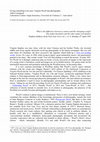
Etudes Britanniques Contemporaines , 2017
The articles presented here aim at seeing how photographic vision shaped Virginia Woolf’s literar... more The articles presented here aim at seeing how photographic vision shaped Virginia Woolf’s literary aesthetics, her relation to language and characterisation, and her approach of literary representation and life writing. Woolf’s relation to photography is threefold: she practices the art of mechanical reproduction (taking and developing photographs, making photo albums), a praxis which is enriched by a strong family heritage and fostered by the contemporary Kodak culture; she is immersed in a photo culture which embraces 19th-century and 20th-century aesthetics, and nurtures her theoretical and literary reflexions; and she uses photo images as rhetorical tools in the iconotexts she publishes with the Hogarth Press. Focusing on Woolf studies on photography, Julia Margaret Cameron’s legacy, the intricate links between photography and biographical writing, and interruptive stylistics in Jacob’s Room, the four contributions further Maggie Humm’s pioneering work and provide renewed perspectives on Woolf’s complex relation to photography.
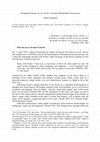
C. Davison & A-M Smith-Di Biasio (ed.), Trans-Woolf. Thinking Across Borders, 2017
Quiet and enigmatic Jacob Flanders is "statuesque, noble and eyeless", a suggestive and strong pr... more Quiet and enigmatic Jacob Flanders is "statuesque, noble and eyeless", a suggestive and strong presence, "composed, commanding, contemptuous", which, paradoxically, strikes us as ghostly, eerie and evanescent. Jacob is tangible and embodied but blurry and vanishing; oscillating between the immaculate concreteness of Greek sculpture and the transient immateriality of dark shadows. A truly contradictory and puzzling character, his presence in Jacob's Room is in turn uncanny and oneiric. "[S]tanding in the shadow, and yet alive to every tremor and gleam of existence", he stands as a flickering image, at once contemporary with Woolf's time (a soldier, among many, to die in the trenches) and immemorial (a ghost which has the bearing of Greek gods).
In this paper, I wish to confront the woolfian text to two types of photographic images, the impressive Beresford photographs of Thoby Stephen, which Woolf kept in her Monks House Albums, and photographs of Greek statues which illustrate H. B. Walters's 1905 Greek Art, one of the books Woolf read before leaving for her 1906 trip to Greece; photographs which articulate presence and absence, substance and appearance, reality and fantasy. My aim is to make words and images face each other so as to fathom the creative common ground that they share when it comes to represent what cannot be represented nor articulated: disappearance, mourning and silence, and the inscrutable quality of human existence. I intent to see in what ways the magic and shadowy quality of photographic presence works its way as an optical unconscious, a haunting interpretant shaping a spectral text which challenges inarticulacy.
I shall thus analyse how photographic visibility translates into words to create Jacob's persistent singular vision. At a time when England was still in mourning and spirit photography gained momentum, Woolf conceived Jacob Flanders as a latent or surviving image, memory-image or dream-image, which her readers perceive in the mind "without words".
Le Rêve plastique des écrivains, Jun 2017
La notion de plasticité, délicate à définir, peut être éclairée en fonction du domaine précis dan... more La notion de plasticité, délicate à définir, peut être éclairée en fonction du domaine précis dans lequel elle est contextualisée et envisagée. Le point de vue qui la met au coeur d’une dynamique de pensée est ici celui de l’analyse littéraire. En important dans le champ littéraire une réflexion a priori liée aux arts plastiques, en nommant des modalités de la plasticité révélées dans l’écriture, ce recueil d’articles explore les oeuvres littéraires avec un regard nouveau, une approche originale, car il relève ce qui, dans les écritures, suggère et réalise un rêve des écrivains, la possibilité d’une dimension sensible donnée à leur oeuvre, celle-ci transgressant les limites du lisible pour s’accomplir comme forme également visuelle et visible, sonore et audible.
Revoir 14 images malgré tout ?, Jun 1, 2017
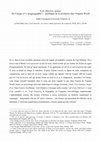
L'oeil littéraire. La vision comme opérateur scriptural, 2015
Nous partirons de la relation que Virginia Woolf entretenait avec les images : prises de vue et c... more Nous partirons de la relation que Virginia Woolf entretenait avec les images : prises de vue et conception d’albums photos depuis sa plus tendre enfance, rédaction de « The Cinema » en 1926, conception d’un roman, Orlando, illustré de photographies et de reproduction de tableau, et création de scrapbooks à partir de coupures de journaux pour l’élaboration de son essai pacifiste Trois Guinées.
Par son vouloir voir passionné, Woolf impose son point de vue. Il s’agit pour elle de percevoir donc de sentir le monde. Il s’agit d’observer donc de comprendre le monde. Je me propose d’étudier une fiction traversée d’images (diégèses, cadres narratifs, lecture) et d’analyser diverses modalités de sa poéthique de la révélation. La révélation est à la base du dispositif texte/image dans Trois Guinées, où l’auteure souhaite éveiller les consciences de ses contemporains aux atrocités de la guerre ainsi qu’à l’inégalité homme/femme. Le texte s’offre alors à notre regard et nous enjoint à une lecture éclairante et participative. Nous verrons en quoi Woolf met en place une convergence des regards par une écriture d’images ou imageographie.
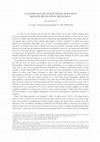
La Licorne. Autour du tiers pictural (thanks to Liliane Louvel), 2014
Dans le texte woolfien, l’image pose le problème de la représentation littéraire. Parole muette, ... more Dans le texte woolfien, l’image pose le problème de la représentation littéraire. Parole muette, elle questionne, reforme autant qu’elle réforme la tradition réaliste héritée du 19e siècle victorien. Qu’elles soient actuelles ou virtuelles, les images nourrissent ses œuvres jusqu’à participer à l’élaboration d’une écriture traversée d’images (imageographie) qui fait du texte littéraire un lieu entre-deux, un dispositif composite et complexe.
Dans "Un collège féminin vu de l’extérieur", "La robe neuve" et "La Dame dans le miroir : réflexion", le motif de la femme au miroir fait image. Travaillant sur le surgissement éphémère (à la fois événement et avènement) d’un reflet dans un miroir, les nouvelles dévoilent un inconscient photographique (survivance virtuelle de l’image au sein du texte) qui dévie et perturbe le sens. Nous verrons en quoi le topos (littéraire et pictural) du miroir apparaît à la fois comme motif en texte et comme stratégie de représentation pour remettre en cause textes et images dans leur volonté d’exprimer et retenir ce qui échappe, dans leur vanité à vouloir capter et dire l’évanescent, tout en le fixant, le figeant. Le texte woolfien travaille ainsi sur ses propres limites, redéfinissant par la notre rapport au réel. Je propose d’analyser en quoi le tiers pictural permet de mettre en valeur la question de l’illusion, qu’elle soit identitaire ("Un collège féminin vu de l’extérieur"), sociale ("La robe neuve") ou littéraire ("La Dame dans le miroir : réflexion").
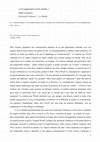
Contemporary Woolf/Woolf Contemporaine, 2014
Pour Woolf le contemporain est un espace-temps évanescent et sans cesse renouvelé. Il s’épanouit ... more Pour Woolf le contemporain est un espace-temps évanescent et sans cesse renouvelé. Il s’épanouit dans ces moments d’être qui disparaissent avant de réapparaître à la surface de la mémoire. Nous proposons d’étudier ce rapport complexe et fluctuant à travers la relation que Woolf entretient avec l’image, qu’elle soit photographique ou picturale. Nous verrons en quoi Woolf utilise la photographie pour réfléchir au contemporain en s’ancrant dans un présent auquel elle réagit de manière épidermique. Le dispositif texte/image dans Three Guineas (1938) nous servira de base pour étudier son rapport à une temporalité courte et délimitée, à une urgence contemporaine à la fois sociale et politique.
Nous proposons ensuite de mettre en parallèle les visions développées par Woolf et par le peinte James Whistler afin de faire l’étude de deux trajectoires similaires qui mettent en lumière le rapport ambigu que l’artiste entretien avec le contemporain. A la charnière entre le 19e siècle et le 20e siècle, l’écrivaine et le peintre problématisent leur rapport à la création au sein même d’œuvres qui se font écrin et écran d’un monde en mutation permanente. Se basant sur l’analyse croisée d’extraits de The Waves (1931) et de certaines « harmonies » et « symphonies » whistleriennes, nous verrons comment tout deux bâtissent des œuvres mouvantes, vibrantes et versatiles, faites d’un réseau d’échos réminiscent des correspondances baudelairiennes. Nous verrons en quoi leurs difficultés à penser le contemporain les mènent à glisser dans l’a-contemporain, comme dans l’a-temporalité.
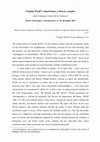
Etudes Britanniques Contemporaines 43, 2012
Virginia Woolf’s central section in To the Lighthouse hinges upon the oxymoric nature of ruin, an... more Virginia Woolf’s central section in To the Lighthouse hinges upon the oxymoric nature of ruin, and ponders over disappearance. The family house is victim of a time that passes irremediably, yet remains and endures. In Woolf’s ‘elegy’, the Ramsays’ ruined and empty house is pictured as a transitional spectral place (visible/invisible, light/darkness, life/death), articulating waste and decay and the progressive vanishing of an older order and heritage with the promise of reconstruction through metamorphosis.
We will see how through the ramshackle house Woolf reflects upon war (destruction, dislocation, fragmentation), mourning (decay, dust, darkness) and Time (memory). The text is born out of a reflexion about duration. Time is here a question put to humanity and literature, a question without definite answer, but rather a perpetual reworking of the question. We will see that Woolf uses the ruined house as a structural motif in To the Lighthouse to try and express the inexpressible in troubled times (traumatic aftermath of WWI). The ruin becomes a lieu de mémoire through striking images (influence of photography and cinema linked to questions of time and remembrance), a place of resistance too, underlining the crucial function of art when a whole civilisation is threatened by destruction.
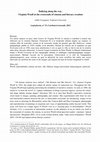
Caliban 33, 2013
Peter, Clarissa, Richard, Septimus or the mysterious passante, all wait or hesitate to cross stre... more Peter, Clarissa, Richard, Septimus or the mysterious passante, all wait or hesitate to cross streets, they walk across London, cross parks and rooms, meeting friends or anonyms on their way. They move forward, reach beyond, stop and go, move by fits and starts, tracing paths that converge or branch out. Their thought process and body motion merge in streams of consciousness that map out a day of June in London. Both thematically and structurally, Virginia Woolf’s Mrs Dalloway is built on a crossroads dynamic.
I will consider this peripatetic novel as “a meeting place of dissemblables”, as the meeting place of text and moving images. Following Regis Debray’s mediological approach, I will analyse the modernist text through the relationship between literature and cinematic aesthetics. I will see how from actual images (turn-of-the-century film techniques) Woolf creates virtual images (kinetic prose), which are eventually turned into mental images through the act of reading (reader’s mind’s eye). Woolf explores in-betweeness, and the connection between text and movement-images helps her ponder over the creative acts of writing and reading, and over the building of the Self (identity, experience, memory). I will see in what ways Mrs Dalloway takes its shape between thoughts and movement, space and time, action and memory, words and images.
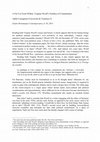
Etudes Britanniques Contemporaines 45, 2013
In Virginia Woolf’s work outrage does not manifest itself bluntly and is never assimilated to sha... more In Virginia Woolf’s work outrage does not manifest itself bluntly and is never assimilated to sharp animosity. Anger is a feeling she deems insincere in fiction and which eventually leads to the loss of ‘perfect integrity’. Woolf argues in favour of a subtle balance, a need to ‘attempt to alter the current scale of values’ through a different vision. A need to assert oneself as Other through the subversive power of words, to resist the prevailing order of things.
The aim of this paper is to see how socio-political concerns arise in Woolf’s essays and seep through her works of fiction to eventually be connected with literary aesthetics that engage the reader. I focus on the novel she wrote after the Great War, Night and Day (1919), to see in what ways the major themes of the novel (marriage and the status of women) strongly link public and private spheres and come to question both society and politics at the beginning of the 20th century. Following Meschonnic’s ideas in Modernité modernité, I argue that literature becomes the place of a textual crisis that witnesses the birth of the modern Subject.
In the article, I analyse the ways in which Woolf focuses on the figure of the New Woman, the embodiment of her rebellion against patriarchy, to tie up two contrasting sets of images—that of the idealised Victorian Angel in the House (Night and Day and photographs of Julia Margaret Cameron) and proliferating images that represent the triumph of patriarchy (Three Guineas and newspaper cuttings)—to overcome, question and redefine socio-political concerns linked to femininity and discourse.
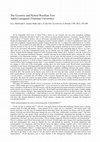
In and Out. Eccentricity in Britain, 2012
Virginia Woolf is very often regarded as an eccentric writer, an uncommon figure in the English l... more Virginia Woolf is very often regarded as an eccentric writer, an uncommon figure in the English literary landscape. Dealing with social, literary and aesthetic issues, she frequently depicts unusual, atypical characters such as a snail as main focalizer of “Kew Gardens”, Flush the dog-narrator, the mad man Septimus in Mrs Dalloway, or the androgynous Orlando, man then woman, who synthesizes Woolf’s vision of the extravagant, eccentric character.
We wish to explore Woolf’s use of eccentricity as a textual motif but also as a fictional process, taking into account cases less extreme than those previously mentioned. Many woolfian narrators adopt eccentric points of view. We read “The Lady in the Looking-Glass” from the side, and we read about Jacob, in his empty room, eventually not seeing him (Jacob’s Room). We may consider those renewed perspectives, which sometimes borrow from the art of pictorial composition, as a form of literary transgression that echoes socio-cultural and aesthetic considerations at the turn of the 20th century. Woolf stands outside the frame of conventions, almost an outlaw, as she refuses to follow the path trod by the British 19th-century realist “materialists”.
With Orlando and Three Guineas, she even creates eccentric textual devices, as photographs and paintings come along with the text and eventually displace our reading, throwing it off centre. Indeed, they disturb Woolf’s works and come to somewhat redefine her approach of literature in the 1930s. In that perspective, we shall see how Woolf introduces an in-between surfacing the text between writing and picturing, offering us a decentred eccentric reading field that we have to invest.
Book Reviews by Adèle Cassigneul
Acta Fabula, 2019
A propos de : Catherine Bernard, Matière à réflexion. Du corps politique dans la littérature et l... more A propos de : Catherine Bernard, Matière à réflexion. Du corps politique dans la littérature et les arts visuels britanniques contemporains, Paris : PUPS, coll. « Mondes anglophones », 2018, 362 p., ISBN 9791023105964 Acta Fabula, vol. 20 No2, Fév 2019 (https://www.fabula.org/revue/document12036.php) [I]l y a, à ma connaissance, pas d'art valable ou authentique où on ne sente pas la cassure qu'on éprouve en regardant le monde après une nuit de cauchemars, brisé et perplexe. Imré Kertész, « Eurêka ! », Discours de réception du prix Nobel 2002
La Vie des idées, 2018
Au sortir de la Seconde Guerre mondiale, artistes et intellectuels sont convaincus que la créatio... more Au sortir de la Seconde Guerre mondiale, artistes et intellectuels sont convaincus que la création a un rôle déterminant à jouer dans la reconstruction du monde. Paris renaît entre art et philosophie, liberté sexuelle et utopie politique.
La Vie des idées, 2018
Les photographes de Provoke, éphémère revue qui secoua la scène artistique japonaise en 1968, sou... more Les photographes de Provoke, éphémère revue qui secoua la scène artistique japonaise en 1968, souhaitaient « provoquer la pensée » et dénoncer la violence d’État. Leur art photo-politique réussit à définir une communauté combattante.

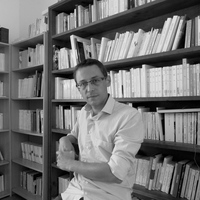

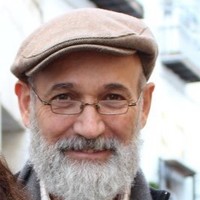
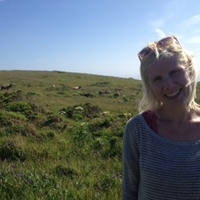

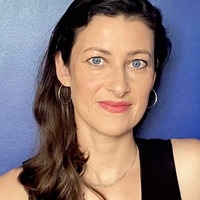
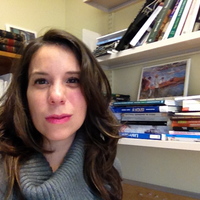

Uploads
Papers by Adèle Cassigneul
//
« A Haunted House » de Virginia Woolf déjoue toutes attentes lectorielles. La nouvelle à la fois reprend et transgresse les lois de son genre, la ghost story ; elle s'impose comme un texte moderniste ludique et réflexif, véritable espace intermédiaire de hantise. Cet article analyse en quoi la nouvelle est hantée par des textes comme par des images ce qui en fait le site d'un héritage autant qu'un espace créatif de subversion, le lieu d'expression d'un geste expérimental émancipateur et d'une littérature qui, au début du vingtième siècle, est en crise.
In this paper, I wish to confront the woolfian text to two types of photographic images, the impressive Beresford photographs of Thoby Stephen, which Woolf kept in her Monks House Albums, and photographs of Greek statues which illustrate H. B. Walters's 1905 Greek Art, one of the books Woolf read before leaving for her 1906 trip to Greece; photographs which articulate presence and absence, substance and appearance, reality and fantasy. My aim is to make words and images face each other so as to fathom the creative common ground that they share when it comes to represent what cannot be represented nor articulated: disappearance, mourning and silence, and the inscrutable quality of human existence. I intent to see in what ways the magic and shadowy quality of photographic presence works its way as an optical unconscious, a haunting interpretant shaping a spectral text which challenges inarticulacy.
I shall thus analyse how photographic visibility translates into words to create Jacob's persistent singular vision. At a time when England was still in mourning and spirit photography gained momentum, Woolf conceived Jacob Flanders as a latent or surviving image, memory-image or dream-image, which her readers perceive in the mind "without words".
Par son vouloir voir passionné, Woolf impose son point de vue. Il s’agit pour elle de percevoir donc de sentir le monde. Il s’agit d’observer donc de comprendre le monde. Je me propose d’étudier une fiction traversée d’images (diégèses, cadres narratifs, lecture) et d’analyser diverses modalités de sa poéthique de la révélation. La révélation est à la base du dispositif texte/image dans Trois Guinées, où l’auteure souhaite éveiller les consciences de ses contemporains aux atrocités de la guerre ainsi qu’à l’inégalité homme/femme. Le texte s’offre alors à notre regard et nous enjoint à une lecture éclairante et participative. Nous verrons en quoi Woolf met en place une convergence des regards par une écriture d’images ou imageographie.
Dans "Un collège féminin vu de l’extérieur", "La robe neuve" et "La Dame dans le miroir : réflexion", le motif de la femme au miroir fait image. Travaillant sur le surgissement éphémère (à la fois événement et avènement) d’un reflet dans un miroir, les nouvelles dévoilent un inconscient photographique (survivance virtuelle de l’image au sein du texte) qui dévie et perturbe le sens. Nous verrons en quoi le topos (littéraire et pictural) du miroir apparaît à la fois comme motif en texte et comme stratégie de représentation pour remettre en cause textes et images dans leur volonté d’exprimer et retenir ce qui échappe, dans leur vanité à vouloir capter et dire l’évanescent, tout en le fixant, le figeant. Le texte woolfien travaille ainsi sur ses propres limites, redéfinissant par la notre rapport au réel. Je propose d’analyser en quoi le tiers pictural permet de mettre en valeur la question de l’illusion, qu’elle soit identitaire ("Un collège féminin vu de l’extérieur"), sociale ("La robe neuve") ou littéraire ("La Dame dans le miroir : réflexion").
Nous proposons ensuite de mettre en parallèle les visions développées par Woolf et par le peinte James Whistler afin de faire l’étude de deux trajectoires similaires qui mettent en lumière le rapport ambigu que l’artiste entretien avec le contemporain. A la charnière entre le 19e siècle et le 20e siècle, l’écrivaine et le peintre problématisent leur rapport à la création au sein même d’œuvres qui se font écrin et écran d’un monde en mutation permanente. Se basant sur l’analyse croisée d’extraits de The Waves (1931) et de certaines « harmonies » et « symphonies » whistleriennes, nous verrons comment tout deux bâtissent des œuvres mouvantes, vibrantes et versatiles, faites d’un réseau d’échos réminiscent des correspondances baudelairiennes. Nous verrons en quoi leurs difficultés à penser le contemporain les mènent à glisser dans l’a-contemporain, comme dans l’a-temporalité.
We will see how through the ramshackle house Woolf reflects upon war (destruction, dislocation, fragmentation), mourning (decay, dust, darkness) and Time (memory). The text is born out of a reflexion about duration. Time is here a question put to humanity and literature, a question without definite answer, but rather a perpetual reworking of the question. We will see that Woolf uses the ruined house as a structural motif in To the Lighthouse to try and express the inexpressible in troubled times (traumatic aftermath of WWI). The ruin becomes a lieu de mémoire through striking images (influence of photography and cinema linked to questions of time and remembrance), a place of resistance too, underlining the crucial function of art when a whole civilisation is threatened by destruction.
I will consider this peripatetic novel as “a meeting place of dissemblables”, as the meeting place of text and moving images. Following Regis Debray’s mediological approach, I will analyse the modernist text through the relationship between literature and cinematic aesthetics. I will see how from actual images (turn-of-the-century film techniques) Woolf creates virtual images (kinetic prose), which are eventually turned into mental images through the act of reading (reader’s mind’s eye). Woolf explores in-betweeness, and the connection between text and movement-images helps her ponder over the creative acts of writing and reading, and over the building of the Self (identity, experience, memory). I will see in what ways Mrs Dalloway takes its shape between thoughts and movement, space and time, action and memory, words and images.
The aim of this paper is to see how socio-political concerns arise in Woolf’s essays and seep through her works of fiction to eventually be connected with literary aesthetics that engage the reader. I focus on the novel she wrote after the Great War, Night and Day (1919), to see in what ways the major themes of the novel (marriage and the status of women) strongly link public and private spheres and come to question both society and politics at the beginning of the 20th century. Following Meschonnic’s ideas in Modernité modernité, I argue that literature becomes the place of a textual crisis that witnesses the birth of the modern Subject.
In the article, I analyse the ways in which Woolf focuses on the figure of the New Woman, the embodiment of her rebellion against patriarchy, to tie up two contrasting sets of images—that of the idealised Victorian Angel in the House (Night and Day and photographs of Julia Margaret Cameron) and proliferating images that represent the triumph of patriarchy (Three Guineas and newspaper cuttings)—to overcome, question and redefine socio-political concerns linked to femininity and discourse.
We wish to explore Woolf’s use of eccentricity as a textual motif but also as a fictional process, taking into account cases less extreme than those previously mentioned. Many woolfian narrators adopt eccentric points of view. We read “The Lady in the Looking-Glass” from the side, and we read about Jacob, in his empty room, eventually not seeing him (Jacob’s Room). We may consider those renewed perspectives, which sometimes borrow from the art of pictorial composition, as a form of literary transgression that echoes socio-cultural and aesthetic considerations at the turn of the 20th century. Woolf stands outside the frame of conventions, almost an outlaw, as she refuses to follow the path trod by the British 19th-century realist “materialists”.
With Orlando and Three Guineas, she even creates eccentric textual devices, as photographs and paintings come along with the text and eventually displace our reading, throwing it off centre. Indeed, they disturb Woolf’s works and come to somewhat redefine her approach of literature in the 1930s. In that perspective, we shall see how Woolf introduces an in-between surfacing the text between writing and picturing, offering us a decentred eccentric reading field that we have to invest.
Book Reviews by Adèle Cassigneul
//
« A Haunted House » de Virginia Woolf déjoue toutes attentes lectorielles. La nouvelle à la fois reprend et transgresse les lois de son genre, la ghost story ; elle s'impose comme un texte moderniste ludique et réflexif, véritable espace intermédiaire de hantise. Cet article analyse en quoi la nouvelle est hantée par des textes comme par des images ce qui en fait le site d'un héritage autant qu'un espace créatif de subversion, le lieu d'expression d'un geste expérimental émancipateur et d'une littérature qui, au début du vingtième siècle, est en crise.
In this paper, I wish to confront the woolfian text to two types of photographic images, the impressive Beresford photographs of Thoby Stephen, which Woolf kept in her Monks House Albums, and photographs of Greek statues which illustrate H. B. Walters's 1905 Greek Art, one of the books Woolf read before leaving for her 1906 trip to Greece; photographs which articulate presence and absence, substance and appearance, reality and fantasy. My aim is to make words and images face each other so as to fathom the creative common ground that they share when it comes to represent what cannot be represented nor articulated: disappearance, mourning and silence, and the inscrutable quality of human existence. I intent to see in what ways the magic and shadowy quality of photographic presence works its way as an optical unconscious, a haunting interpretant shaping a spectral text which challenges inarticulacy.
I shall thus analyse how photographic visibility translates into words to create Jacob's persistent singular vision. At a time when England was still in mourning and spirit photography gained momentum, Woolf conceived Jacob Flanders as a latent or surviving image, memory-image or dream-image, which her readers perceive in the mind "without words".
Par son vouloir voir passionné, Woolf impose son point de vue. Il s’agit pour elle de percevoir donc de sentir le monde. Il s’agit d’observer donc de comprendre le monde. Je me propose d’étudier une fiction traversée d’images (diégèses, cadres narratifs, lecture) et d’analyser diverses modalités de sa poéthique de la révélation. La révélation est à la base du dispositif texte/image dans Trois Guinées, où l’auteure souhaite éveiller les consciences de ses contemporains aux atrocités de la guerre ainsi qu’à l’inégalité homme/femme. Le texte s’offre alors à notre regard et nous enjoint à une lecture éclairante et participative. Nous verrons en quoi Woolf met en place une convergence des regards par une écriture d’images ou imageographie.
Dans "Un collège féminin vu de l’extérieur", "La robe neuve" et "La Dame dans le miroir : réflexion", le motif de la femme au miroir fait image. Travaillant sur le surgissement éphémère (à la fois événement et avènement) d’un reflet dans un miroir, les nouvelles dévoilent un inconscient photographique (survivance virtuelle de l’image au sein du texte) qui dévie et perturbe le sens. Nous verrons en quoi le topos (littéraire et pictural) du miroir apparaît à la fois comme motif en texte et comme stratégie de représentation pour remettre en cause textes et images dans leur volonté d’exprimer et retenir ce qui échappe, dans leur vanité à vouloir capter et dire l’évanescent, tout en le fixant, le figeant. Le texte woolfien travaille ainsi sur ses propres limites, redéfinissant par la notre rapport au réel. Je propose d’analyser en quoi le tiers pictural permet de mettre en valeur la question de l’illusion, qu’elle soit identitaire ("Un collège féminin vu de l’extérieur"), sociale ("La robe neuve") ou littéraire ("La Dame dans le miroir : réflexion").
Nous proposons ensuite de mettre en parallèle les visions développées par Woolf et par le peinte James Whistler afin de faire l’étude de deux trajectoires similaires qui mettent en lumière le rapport ambigu que l’artiste entretien avec le contemporain. A la charnière entre le 19e siècle et le 20e siècle, l’écrivaine et le peintre problématisent leur rapport à la création au sein même d’œuvres qui se font écrin et écran d’un monde en mutation permanente. Se basant sur l’analyse croisée d’extraits de The Waves (1931) et de certaines « harmonies » et « symphonies » whistleriennes, nous verrons comment tout deux bâtissent des œuvres mouvantes, vibrantes et versatiles, faites d’un réseau d’échos réminiscent des correspondances baudelairiennes. Nous verrons en quoi leurs difficultés à penser le contemporain les mènent à glisser dans l’a-contemporain, comme dans l’a-temporalité.
We will see how through the ramshackle house Woolf reflects upon war (destruction, dislocation, fragmentation), mourning (decay, dust, darkness) and Time (memory). The text is born out of a reflexion about duration. Time is here a question put to humanity and literature, a question without definite answer, but rather a perpetual reworking of the question. We will see that Woolf uses the ruined house as a structural motif in To the Lighthouse to try and express the inexpressible in troubled times (traumatic aftermath of WWI). The ruin becomes a lieu de mémoire through striking images (influence of photography and cinema linked to questions of time and remembrance), a place of resistance too, underlining the crucial function of art when a whole civilisation is threatened by destruction.
I will consider this peripatetic novel as “a meeting place of dissemblables”, as the meeting place of text and moving images. Following Regis Debray’s mediological approach, I will analyse the modernist text through the relationship between literature and cinematic aesthetics. I will see how from actual images (turn-of-the-century film techniques) Woolf creates virtual images (kinetic prose), which are eventually turned into mental images through the act of reading (reader’s mind’s eye). Woolf explores in-betweeness, and the connection between text and movement-images helps her ponder over the creative acts of writing and reading, and over the building of the Self (identity, experience, memory). I will see in what ways Mrs Dalloway takes its shape between thoughts and movement, space and time, action and memory, words and images.
The aim of this paper is to see how socio-political concerns arise in Woolf’s essays and seep through her works of fiction to eventually be connected with literary aesthetics that engage the reader. I focus on the novel she wrote after the Great War, Night and Day (1919), to see in what ways the major themes of the novel (marriage and the status of women) strongly link public and private spheres and come to question both society and politics at the beginning of the 20th century. Following Meschonnic’s ideas in Modernité modernité, I argue that literature becomes the place of a textual crisis that witnesses the birth of the modern Subject.
In the article, I analyse the ways in which Woolf focuses on the figure of the New Woman, the embodiment of her rebellion against patriarchy, to tie up two contrasting sets of images—that of the idealised Victorian Angel in the House (Night and Day and photographs of Julia Margaret Cameron) and proliferating images that represent the triumph of patriarchy (Three Guineas and newspaper cuttings)—to overcome, question and redefine socio-political concerns linked to femininity and discourse.
We wish to explore Woolf’s use of eccentricity as a textual motif but also as a fictional process, taking into account cases less extreme than those previously mentioned. Many woolfian narrators adopt eccentric points of view. We read “The Lady in the Looking-Glass” from the side, and we read about Jacob, in his empty room, eventually not seeing him (Jacob’s Room). We may consider those renewed perspectives, which sometimes borrow from the art of pictorial composition, as a form of literary transgression that echoes socio-cultural and aesthetic considerations at the turn of the 20th century. Woolf stands outside the frame of conventions, almost an outlaw, as she refuses to follow the path trod by the British 19th-century realist “materialists”.
With Orlando and Three Guineas, she even creates eccentric textual devices, as photographs and paintings come along with the text and eventually displace our reading, throwing it off centre. Indeed, they disturb Woolf’s works and come to somewhat redefine her approach of literature in the 1930s. In that perspective, we shall see how Woolf introduces an in-between surfacing the text between writing and picturing, offering us a decentred eccentric reading field that we have to invest.
Après avoir replacé l'œuvre dans son contexte moderniste et souligné l'importance du rôle joué par la Hogarth Press, qui permet à l'écrivaine d'intégrer des images en texte, nous mettons en évidence le cinématisme de ses œuvres à travers l'exploration photo-filmique de la ville moderne et la structuration en montage du flux de conscience. Nous considérons ensuite le battement anachronique des fluctuations temporelles qui structurent l'œuvre dans ses phénomènes mémoriels de hantise et de survivance, l'image faisant retour en texte dans une durée contractée (instantané) ou dilatée (défilé d'images), à la fois personnelle et intime, collective et historique. Nous envisageons enfin le texte comme un espace de négociation subversif où l'image permet à l'auteure de prendre position poéthiquement, alors que sont mis en scène des personnages atypiques à l'identité inassignable.
This study contends that Virginia Woolf's writing draws its inspiration from Julia Margaret Cameron's Victorian photographs, the 1920s avant-garde photography and cinema, and Woolf's own Monk's House Albums, making her work at once photographic and cinematographic, or photo-cinematographic. Exploring the Woolfian text as a complex representation device, I examine the plasticity of its prose and narrative strategies to show how photography and cinema help to shape its aesthetic, but also ethical and political contents.
This thesis first places Woolf's works in their modernist context and underlines the part played by the Hogarth Press, enabling Woolf to include images in her texts. I then shed light on the kinematic aspect of her work by analysing the photo-filmic exploration of the London scene and the montage of stream of consciousness. The third part probes into the anachronic rhythm of fluctuating time, emphasising the haunting aspects of memory through surviving images that condense their temporality in the instant (snapshot) or unroll it (streaming images) ; thus time achieves a personal and intimate, but also collective and historical dimension. Finally, I look at the Woolfian text as a subversive place of negotiation inhabited by eccentric characters with elusive identities and in which images help the author to make a poethical stand.
In this way, forgetting can be considered as the springboard of memory (rather than its sheer negation), what makes recollection possible. If forgetfulness becomes beneficial, even productive, one may interrogate its relation to creativity and literary creation, oblivion becoming a means of freeing oneself from heritage and tradition. To forget may also heal and restore; it can be linked to reconciliation and appeasement, soothing and forgiveness.
More than its anthropological or psychoanalytical dimensions, we would like to consider the idiosyncratically literary aspects of forgetting. How is oblivion conceived and represented in British literature over the centuries?
A travers l’œuvre littéraire de six femmes, l’Université Populaire de Bordeaux propose de (re)découvrir ce que les romancières d’hier et d’aujourd’hui écrivent afin de voir comment elles perçoivent le monde, comment elles en rendent compte et le donnent à comprendre, et comment elles nous aident à mieux déchiffrer ce que nous sommes.
Tout au long de l’année, des spécialistes de Svetlana Alexievitch, Assia Djebar, Véronique Tadjo, Virginia Woolf, Georges Sand et Annie Ernaux (re)liront les textes de ces écrivaines, s’attardant plus longuement sur certains volumes de leur choix que nous vous invitions à explorer. Le but de ce cycle de conférences est simple : transmettre un plaisir de la lecture pour donner envie de (re)lire et faire connaître les œuvres de celles qui pensent par l’écrit.
One makes facsimiles and the other makes sick families
Stephen children, Hyde Park Gate News vol. 1, n° 9, Monday, 6th April 1891
Virginia Stephen was nine when, with her sister Vanessa and her brother Thoby, she invented riddles and wrote regular chronicles involving photography in the family newspaper. She was still nine when, for Christmas, she drew successive ink vignettes which build up a “story not needing words” . Later, in 1906, while trying to depict “great melancholy moors”, she passionately penned in her diary: “But words! words! You will find nothing to match the picture” . For Woolf, be it through a malicious play on words, a lively succession of images or the expression of a young writer’s frustration, words and images are set in fruitful tension. The quotes mark out the intermedial interaction and emulation underling Woolfian prose, its becoming other.
It is now common knowledge in Woolfian studies that Woolf’s oeuvre enjoys intimate relations with the visual arts; Maggie Humm’s 2010 edition of The Edinburgh Companion to Virginia Woolf and the Arts has proved it admirably. Yet Frances Spalding’s 2014 exhibition at the National Portrait Gallery, “Virginia Woolf. Art, Life and Vision” blatantly showed that Woolf is still mainly related to Post-impressionism and to Bloomsbury pictorial influence. While Maggie Humm and Elena Gualtieri, among others, have brought to the fore the crucial part played by photography in Woolf’s life and cultural environment, there is nonetheless a need to focus on photographic intermediality and its textual effects in the oeuvre. This conference therefore intends to consider how, in its relation to photography, the plasticity of the Woolfian text actually becomes photographic and makes us see.
Thus taking its cue from the preceding SEW seminars and conferences – “Outlanding Woolf” in 2013, “Humble Woolf” in 2014 and “Trans-Woolf” in 2015 – this two-days symposium will explore multiple aspects of Virginia Woolf’s relation to photography.
1. VIRGINIA WOOLF AND IMAGES
One might return to Woolf’s rich family heritage, to what constitutes the studium (Barthes) of her knowledge and practice of photography, namely the work of Julia Margaret Cameron or Leslie Stephen’s 1895 Photograph Album, but also to what François Brunet calls the “Kodak revolution”. In the wake of Humm’s latest articles, these decisive influences might be analysed in relation to (auto)biography, diaristic writing, the need for self-expression and the private recording of daily life.
Between theory, amateurism and actual praxis, Woolf’s intimate relationship to photography might be brought to bear on contemporary French research into visual cultures, thus opening onto ethical as well as aesthetic debates. One might also focus on photography as a humble craft, that is, a “middlebrow” (Bourdieu) or “vernacular” (Chéroux) practice and a “conversational medium” (Ghuntert) which challenges literary writing.
2. BUILDING THE IMAGE/TEXT
Thanks to the Hogarth Press, Woolf printed illustrated books – iconotexts – and included photographs in some of her own productions (Orlando, Flush and Three Guineas). She also collected newspaper articles and press images for her 1930s scrapbooks. One might indeed analyse how the photographic image works in and with the text, how it acts as an actual rhetorical tool, actively contributing to building up the image-text.
One might also reflect on the punctum (Barthes) of Woolfian photographic style, in order to see how photographic visibility translates into words, either through the literal metaphors Woolf uses in both her essays and fiction or through the implicit ones which adapt the photographic process or album design into writing.
3. PHOTOGRAPHY’S INVISIBLE REVOLUTION (Ortel)
Another possible aspect of enquiry might be the photographic unconscious or photographic “third” (Louvel). This could be linked to questions of representation (realism, phenomenology), of perception (optical or mental, the mind’s eye), and of traces (photographic memory, history, haunting in relation to Georges Didi-Huberman’s work).
Last but not least, it would be interesting to try and circumscribe Woolf’s imaginary museum, to delve into her connections with 19th- and 20th-century photographic aesthetics such as Pictorialism, the Kodak snapshot or the 1910s-1920s avant-garde.
Engagée dans un combat contre l'oubli, la production littéraire française et britannique des trente dernières années s'est attachée à figurer les événements de la guerre et a tenté de circonscrire avec les mots ce qui toujours échappe ou ne se dit pas: l'incommensurable horreur de la vie au front, la blessure jamais vraiment pansée du traumatisme, l'indicible douleur de ceux-là qui assistaient impuissants aux désastres de la guerre et le combat étouffé de ceux-ci, pacifistes, qui refusaient de participer à l'effort de guerre.
Vestige d'un temps passé et image-témoin, l'image laisse une trace : que celle-ci soit documentaire ou outil de propagande, qu'elle dénonce la violence guerrière ou face l'apologie d'un patriotisme fervent, l'image prend position et continue de nous regarder, de nous questionner. Entre fantôme et symptôme, l'image survivante hante le texte et marque les textes contemporains de l'empreinte de 1914. En miroir, certains artistes contemporains recherchent dans le paysage l’empreinte qu’a laissée la littérature de la Grande Guerre, ou créent une nouvelle iconographie cherchant à combler l’aporie de l’événement.
Nous souhaiterions ainsi réfléchir au rapport que la littérature, la peinture et la photographie contemporaines entretient avec les images d'archives aujourd'hui disponibles, et comment le 21e siècle se réapproprie, souvent par le biais de l’intermédialité, des faits qui de plus en plus s'éloignent. Il s'agira de comprendre les images qu'il nous reste de 14-18 dans leur relation à l'écriture et à l’art, c'est-à-dire de les inclure dans une réflexion historique et littéraire mais également de les voir, les regarder pour les connaître, les déchiffrer pour saisir une réalité qui désormais nous dépasse, nous échappe mais nous concerne toujours avant de les confronter à la production actuelle.
Nous nous proposons ainsi d’aborder la question de la mémoire - collective ou intime – dans le contexte de la modernité : mémoire contenue, empêchée, réprimée, construite ou reconstruite, autour de ces deux coupures traumatiques que furent la première et la seconde guerre mondiale. Celle-ci implique donc un temps perdu et un temps retrouvé dans le récit ou dans l’image, une béance, un silence, un point inaccessible au langage ainsi qu’un travail compensatoire de restitution et d’aménagement, travail à partir de la survivance de la trace : l'archive, le témoignage, l'image, la mise en récit par le biais de la hantise sont autant de stratégies employées par l’écrivain et l’artiste afin de mettre en résonnance mémoire de l’intime et mémoire de la guerre.
On pourra alors penser le ‘jeu’ de ces mémoires, construction artistique mais également écart signifiant, à l’aune des révolutions techniques de la photographie et du cinéma qui informent la perception de l’histoire. La question nous renvoie donc à la construction du sujet moderne, lequel s’établit, au temps présent, grâce à des processus de composition avec le passé, d’élaboration en récits, en topos, en chronologie et de projection vers l’a-venir ainsi qu’à la correspondance éventuelle entre un sujet moderne et une écriture moderne.
Nous avons organisé, au cours des années précédentes, une série de manifestations du même ordre (concernant une réflexion sur les termes moderne, modernité, modernisme) qui visaient à mettre en présence des universitaires travaillant d'une part en art et littérature et de l'autre en sociologie, histoire des idées et études de cultures.
Le terrain de réflexion sera ici bien sûr le monde anglo-saxon, et souvent même, le monde britannique, mais les réflexions transversales et comparatistes (notamment avec nos collègues de lettres modernes, arts et cinéma) nous permettront par exemple de ré-envisager ces problématiques, à travers l’étude comparative de l’expérience et de la mémoire des deux guerres mondiales, en France et en Grande Bretagne. Y a t-il une convergence des mémoires nationale et collective dans l’aporie des tranchées ou des camps ? Le repli protecteur de la Grande Bretagne lors du Blitz informe-t-il une écriture de la guerre marquée au sceau de l’intime ? Qu’en est-il de l’écriture d’un sujet moderne par des écrivains de la postmodernité ?
Nous proposons de considérer l’éphémère – moment de transition, instant d’inflexion – comme une notion paradoxale, dans la mesure où il incarne nos devenirs et où il se donne aussi comme un aléa susceptible de détourner le cours des choses. Nous nous intéresserons à ce qui fonde le paradoxe de l’éphémère : l’articulation problématique du continu et du discontinu qui transparaît dans l’« instant de vie », la tension entre le ponctuel et la durée, la fulgurance épiphanique et le flux de conscience.
L’éphémère implique dans un même temps une conscience du temps et une pensée de son inconsistance. L’éphémère accompagne aussi les états de mutation, de crise, qui impulsent de nouvelles dynamiques et fondent notre expérience. L’éphémère est une présence-absence, un spasme temporel, un jaillissement qui contient déjà l’avènement de sa propre mort. Il échappe à la doxa, car, irréductible, il résiste à toute tentative de le fixer.
Nous articulerons la réflexion sur l’éphémère à la question de la modernité, de la notion générique associée au Modernisme du début du XXe siècle à la nouveauté qui nous est contemporaine en ce début du XXIe siècle. Nous envisagerons ainsi les modalités de l’évolution, voire du renversement du sens de l’éphémère jusqu’à nos jours.
Sorte de point aveugle théorique, l’éphémère est une notion en creux qui fascine et interroge. C’est dans cette perspective que nous proposons de réfléchir sur les manifestations de ce concept qui fait vaciller les concepts, dans une démarche multidisciplinaire et transversale, puisque l’éphémère nous paraît à l’origine de l’élaboration du Sujet, d’un discours littéraire, d’une expression artistique.
Spleen, crise du sujet lyrique et angoisse du temps qui passe : entre flux et figé, l’expression littéraire et artistique (par exemple, la poésie et la photographie) se retrouve et cristallise les paradoxes de l’éphémère, capturant le fugace et retenant la présence illusoire de ce qui n’est plus, se donnant comme volonté de retenir le « presque rien » (D. Rabaté), et la certitude du « ça a été » barthésien. En ce sens, la littérature et les arts proposent une poéthique de l’éphémère, à la croisée de l’éthique, de l’esthétique et de l’éthos poétique.
Certains genres littéraires résistent davantage à la notion d’éphémère, tout en cherchant à l’intégrer : c’est par exemple le cas du roman, dès le tournant du XXe siècle (V. Woolf, J. Joyce, J. Dos Passos, M. Proust, A. Gide, etc. dont les questionnements alimenteront les mouvements de refondation du roman, comme le Nouveau Roman en France). De même, le théâtre contemporain tend à s’éloigner du texte préalablement fixé pour s’affirmer comme performance éphémère. Nous nous demanderons donc si l’éphémère ne va pas de pair avec l’expérimentation (avant-gardes littéraire et artistique) et l’hybridité des genres (écriture visuelle, poésie sonore, etc.).
Au vu du développement de nouvelles pratiques littéraires et artistiques – performances et « créations », traitement postmoderne de formes littéraires traditionnelle – ainsi que de l’émergence de nouveaux supports liés à internet et au numérique (Twitter et les « Keitai roman » - ou roman SMS – qui réinventent le feuilleton, etc.) une question s’impose : l’éphémère est-il l’apanage de notre modernité ?
Dès lors, comment et où pourrait se situer le sujet ? Se définit-il encore par sa relation à l'histoire et au territoire et serait-ce là ce qui en fait un citoyen ? Ou bien est-ce un rapport plus existentiel au présent qui le constitue en tant qu'individu ?
Cette journée d'étude à pour ambition de faire circuler la réflexion entre civilisation, lettres et histoire des idées pour amorcer un dialogue transversal que nous espérons fécond.